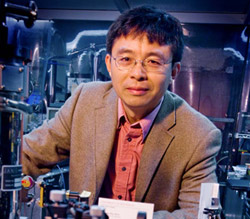
Now, Xiaoyang Zhu, a professor of chemistry at the University of Texas at Austin, has found that the efficiency of conventional solar cells could be greatly increased. The researcher and his team have discovered that it’s possible to double the number of electrons harvested from one photon of sunlight using an organic plastic semiconductor material.
“Plastic semiconductor solar cell production has great advantages, one of which is low cost,” said Zhu. “Combined with the vast capabilities for molecular design and synthesis, our discovery opens the door to an exciting new approach for solar energy conversion, leading to much higher efficiencies.”
The researchers have discovered that a photon produces a dark quantum “shadow state†from which two electrons can then be efficiently captured to generate more energy in the semiconductor pentacene. Zhu said that exploiting that mechanism could increase solar cell efficiency to 44 percent without the need for focusing a solar beam, which would encourage more widespread use of solar technology.
The maximum theoretical efficiency of the silicon solar cell that is the current standard is approximately 31 per cent. That is so because much of the sun’s energy hitting the cell is too high to be turned into usable electricity. What happens then is that energy is lost as heat in the form of ‘hot electrons.’ Capturing those hot electrons could potentially increase the efficiency of solar-to-electric power conversion to as high as 66 percent.
The findings of the research were published in yesterday’s issue of Science magazine. In 2010, Zhu’s team demonstrated the hot electrons could be captured with semiconductor nanocrystals. But it turned out the implementation of a viable technology based on that research was very challenging.
The research team was led by Wai-lun Chan, a postdoctoral fellow in Zhu’s group, with the help of postdoctoral fellows Manuel Ligges, Askat Jailaubekov, Loren Kaake and Luis Miaja-Avila. The research was supported by the National Science Foundation and the Department of Energy.
You should follow us here.





